The Pizza Quest Challenge Pizza Dough

Kelly Whitaker putting the finishing touches on our Challenge Pizza at The Bruery.
 blend, there is also a small amount of pumpernickel rye flour. The actual amount is a proprietary company secret but in our version, for those who can’t get their hands on Germania — which you would have to buy directly from Central Milling (see the end of the recipe) — I will give some suggestions below for creating your own version. The malt crystal is a non-diastatic powder, meaning that the diastase enzymes found in barley malt have been deactivated during heat treatment and thus it is used strictly for flavor and not for it’s enzyme function. We use approx. 4% malt to flour, which is a generous amount. Three ways to obtain the malt is through beer making supply stores or to go to your favorite micro-brewery and ask to buy some from them, or, when you call Central Milling to buy this flour, ask them if you can buy a pound of the malt (that’s where I got mine). OR, you can buy barley malt syrup from a natural foods market or from your local bagel store, where you can plead your case — some bagel shops will sell you some and others won’t. The syrup is not exactly the same as the crystal but it still adds that nice malted barley flavor that evokes the flavors of malty beer and makes this an ideal pizza crust to enjoy while you’re quaffing down your favorite brew.
blend, there is also a small amount of pumpernickel rye flour. The actual amount is a proprietary company secret but in our version, for those who can’t get their hands on Germania — which you would have to buy directly from Central Milling (see the end of the recipe) — I will give some suggestions below for creating your own version. The malt crystal is a non-diastatic powder, meaning that the diastase enzymes found in barley malt have been deactivated during heat treatment and thus it is used strictly for flavor and not for it’s enzyme function. We use approx. 4% malt to flour, which is a generous amount. Three ways to obtain the malt is through beer making supply stores or to go to your favorite micro-brewery and ask to buy some from them, or, when you call Central Milling to buy this flour, ask them if you can buy a pound of the malt (that’s where I got mine). OR, you can buy barley malt syrup from a natural foods market or from your local bagel store, where you can plead your case — some bagel shops will sell you some and others won’t. The syrup is not exactly the same as the crystal but it still adds that nice malted barley flavor that evokes the flavors of malty beer and makes this an ideal pizza crust to enjoy while you’re quaffing down your favorite brew.
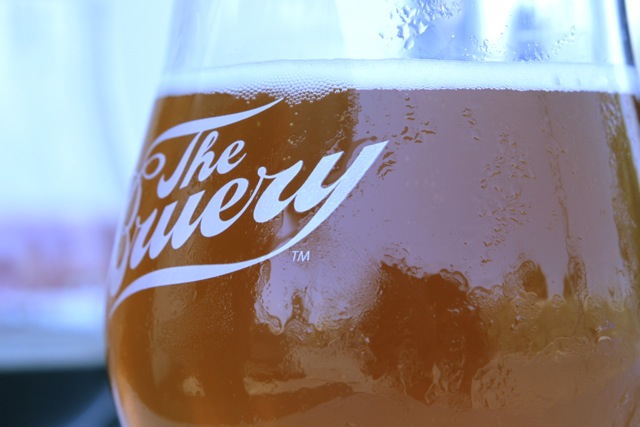
No caption necessary…
Peter about to make the Challenge Dough for a Webisode Demo at The Bruery.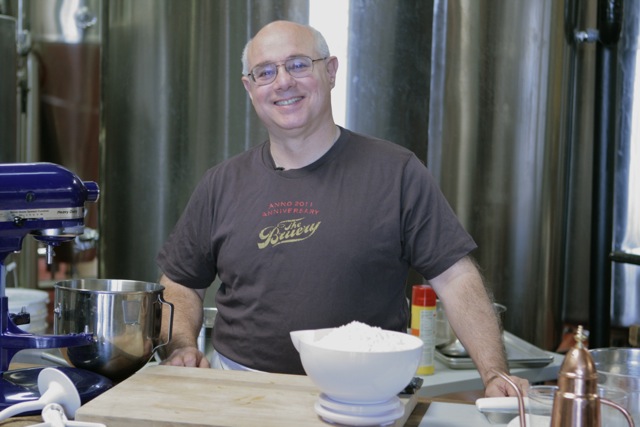
For best results, this dough should be made at least one day in advance–it will also hold in the refrigerator for up to 3 days with good results. Any longer than 3 days and the dough will weaken (start to break down), though it can last for months if shaped into dough balls and frozen in small freezer zip bags.
22 ounces (624 grams) Germania flour or a blend of 20 oz./567 g of your favorite bread or Double Zero flour and 2 oz./56 g of pumpernickel or coarse rye flour or rye meal). If you don’t have a scale, this will be approx. 4 3/4 cups of flour.
0.5 oz/14 g. salt (a scant 2 teaspoons or 2 1/2 teaspoons if using coarse kosher or coarse sea salt)
1 oz./28 g crystal beer malt (light or dark–I use amber) or 1 1/2 tablespoons barley malt syrup
0.11 oz/3 g instant yeast (1 teaspoon) OR, 1 1/4 teaspoons dry active yeast dissolved in 4 ounces of the water for about 3 to 5 minutes
16 oz/452 g water, room temp. (if using Caputo or another Italian Double Zero, reduce the water to 14 oz/399 g)
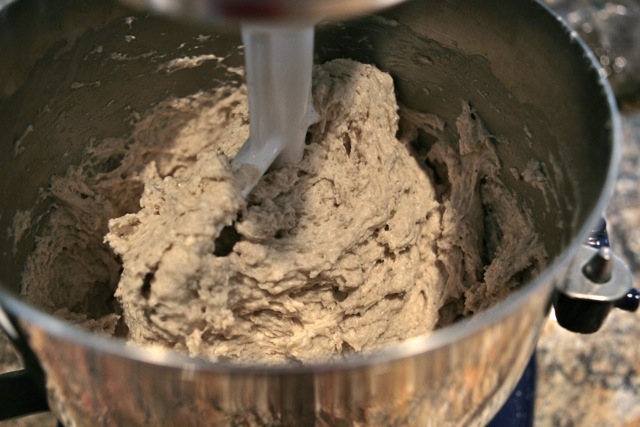
–In an electric mixer, using the paddle attachment, or in a mixing bowl with a large spoon, mix the dough on slow speed for 1 minute, or until the dough is fully hydrated and all the ingredients are evenly distributed (instant yeast goes right into the flour–it does not need to be bloomed in water, while active dry yeast does need dissolving, as described above, by pulling 4 oz. of water from the total). The dough will be coarse and shaggy at this point, and all the ingredients need to be hydrated.
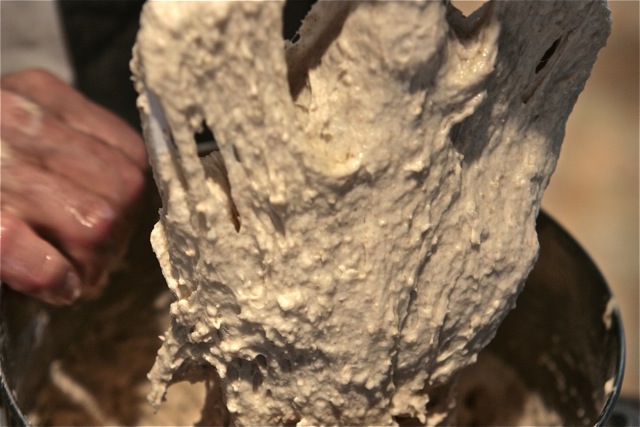
The dough should be very wet and tacky.
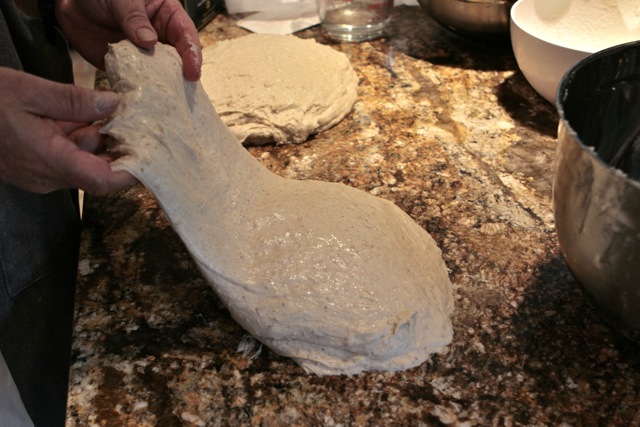
As you stretch and fold the wet dough it slowly becomes more workable.

As you stretch and fold the dough it becomes tighter and less tacky.
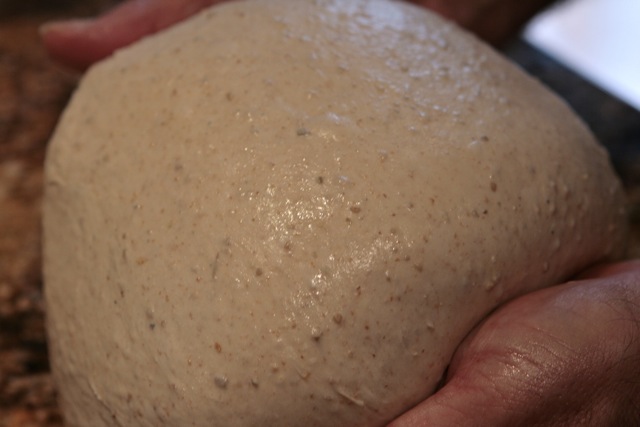
Finally, the dough forms into a nice shiny dough ball.
For more specific details on how to shape or make a pizza, toppings, and sauces refer to our Instructional videos, photos, and recipes, or obtain a copy of “American Pie: My Search for the Perfect Pizza.”
To buy Germania Flour and malt crystal, contact Central Milling at (707) 778-1073, or visit their website at www.centralmilling.com/
Recent Articles by Peter Reinhart
- The Quest for the Top Rock Band Singers of All Time, with Guest Peter Scott Ruben
- Team Rose Bread, The Little Cottage Bakery That Could
- Two Chefs and Marketing Guru Walk Into a Bar (or, What the Freak is Pizza Freak: featuring Brad Daniels, Matt McKenney, and Brad Kilgore)
- Agostino Cangiano and Tatiana Revox, Slicehaus NYC
- “Sourdough” 10th Anniversary Edition with Author Sarah Owens
- The Cheese Dude Returns with His Mt. Rushmore of Cheeses You Must Try Before You Die
Add Comment
You must be logged in to post a comment.







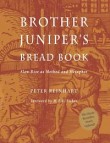


Great article. I can’t wait to try this with pizza dough and other breads as well. A local restaurant near me makes a German stout bread that has notes of chocolate and coffee. I would imagine that it is mostly pumpernickel and a stout beer. I would love to try to duplicate using this method.
Do you have a procedure for using malt (not crystalized)? Any ideas what would happen if you used non-crystallized?
If a beer brewing website lists malt, is it safe to assume all malt is crystallized unless otherwise stated?
For example, is this crystallized?
http://www.rebelbrewer.com/shoppingcart/products/Weyermann-Chocolate-Wheat-Malt-%28by-the-ounce%29.html
Nick’s Birkby’s steeping method uses non crystal malt. You can find it in the most recent Peter’s Blog, dated Sept. 26th. I don’t think all beer malt is crystallized; it often comes as just simply roasted malted barley malt. Crystallized malt is, I believe, a more complex method, like making crystallized, granulated sugar from sugar cane syrup. Best to check with the beer making suppliers to explain the hows and why,s though — I’m still a novice in this realm of malts. Would love to hear what you find out.
Should the salt be 13 grams, not 56 grams, just wondering? Thanks!
You are absolutely correct–my bad! I will change it to 13 grams (actually 14 grams is the correct number, equal to 1/2 oz. of salt as soon as I can get to my home computer. Thank you Tom!!!
Thanks Peter…I read Nick’s article. You mentioned in this article that you would rather use malt than a good beer. Any idea if Nick’s method could be considered better / worse than just substituting your favorite beer for the liquid in the recipe? I am going to post this question on his article as well.
Thanks!